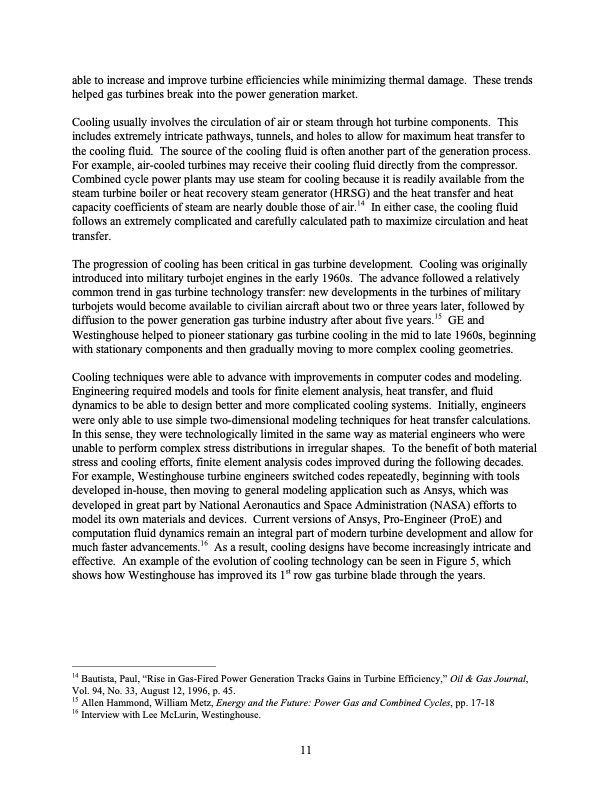
PDF Publication Title:
Text from PDF Page: 017
able to increase and improve turbine efficiencies while minimizing thermal damage. These trends helped gas turbines break into the power generation market. Cooling usually involves the circulation of air or steam through hot turbine components. This includes extremely intricate pathways, tunnels, and holes to allow for maximum heat transfer to the cooling fluid. The source of the cooling fluid is often another part of the generation process. For example, air-cooled turbines may receive their cooling fluid directly from the compressor. Combined cycle power plants may use steam for cooling because it is readily available from the steam turbine boiler or heat recovery steam generator (HRSG) and the heat transfer and heat capacity coefficients of steam are nearly double those of air.14 In either case, the cooling fluid follows an extremely complicated and carefully calculated path to maximize circulation and heat transfer. The progression of cooling has been critical in gas turbine development. Cooling was originally introduced into military turbojet engines in the early 1960s. The advance followed a relatively common trend in gas turbine technology transfer: new developments in the turbines of military turbojets would become available to civilian aircraft about two or three years later, followed by diffusion to the power generation gas turbine industry after about five years.15 GE and Westinghouse helped to pioneer stationary gas turbine cooling in the mid to late 1960s, beginning with stationary components and then gradually moving to more complex cooling geometries. Cooling techniques were able to advance with improvements in computer codes and modeling. Engineering required models and tools for finite element analysis, heat transfer, and fluid dynamics to be able to design better and more complicated cooling systems. Initially, engineers were only able to use simple two-dimensional modeling techniques for heat transfer calculations. In this sense, they were technologically limited in the same way as material engineers who were unable to perform complex stress distributions in irregular shapes. To the benefit of both material stress and cooling efforts, finite element analysis codes improved during the following decades. For example, Westinghouse turbine engineers switched codes repeatedly, beginning with tools developed in-house, then moving to general modeling application such as Ansys, which was developed in great part by National Aeronautics and Space Administration (NASA) efforts to model its own materials and devices. Current versions of Ansys, Pro-Engineer (ProE) and computation fluid dynamics remain an integral part of modern turbine development and allow for much faster advancements.16 As a result, cooling designs have become increasingly intricate and effective. An example of the evolution of cooling technology can be seen in Figure 5, which shows how Westinghouse has improved its 1st row gas turbine blade through the years. 14 Bautista, Paul, “Rise in Gas-Fired Power Generation Tracks Gains in Turbine Efficiency,” Oil & Gas Journal, Vol. 94, No. 33, August 12, 1996, p. 45. 15 Allen Hammond, William Metz, Energy and the Future: Power Gas and Combined Cycles, pp. 17-18 16 Interview with Lee McLurin, Westinghouse. 11PDF Image | Energy RD Performance: Gas Turbine Case Study

PDF Search Title:
Energy RD Performance: Gas Turbine Case StudyOriginal File Name Searched:
criepi.PDFDIY PDF Search: Google It | Yahoo | Bing
NFT (Non Fungible Token): Buy our tech, design, development or system NFT and become part of our tech NFT network... More Info
IT XR Project Redstone NFT Available for Sale: NFT for high tech turbine design with one part 3D printed counter-rotating energy turbine. Be part of the future with this NFT. Can be bought and sold but only one design NFT exists. Royalties go to the developer (Infinity) to keep enhancing design and applications... More Info
Infinity Turbine IT XR Project Redstone Design: NFT for sale... NFT for high tech turbine design with one part 3D printed counter-rotating energy turbine. Includes all rights to this turbine design, including license for Fluid Handling Block I and II for the turbine assembly and housing. The NFT includes the blueprints (cad/cam), revenue streams, and all future development of the IT XR Project Redstone... More Info
Infinity Turbine ROT Radial Outflow Turbine 24 Design and Worldwide Rights: NFT for sale... NFT for the ROT 24 energy turbine. Be part of the future with this NFT. This design can be bought and sold but only one design NFT exists. You may manufacture the unit, or get the revenues from its sale from Infinity Turbine. Royalties go to the developer (Infinity) to keep enhancing design and applications... More Info
Infinity Supercritical CO2 10 Liter Extractor Design and Worldwide Rights: The Infinity Supercritical 10L CO2 extractor is for botanical oil extraction, which is rich in terpenes and can produce shelf ready full spectrum oil. With over 5 years of development, this industry leader mature extractor machine has been sold since 2015 and is part of many profitable businesses. The process can also be used for electrowinning, e-waste recycling, and lithium battery recycling, gold mining electronic wastes, precious metals. CO2 can also be used in a reverse fuel cell with nafion to make a gas-to-liquids fuel, such as methanol, ethanol and butanol or ethylene. Supercritical CO2 has also been used for treating nafion to make it more effective catalyst. This NFT is for the purchase of worldwide rights which includes the design. More Info
NFT (Non Fungible Token): Buy our tech, design, development or system NFT and become part of our tech NFT network... More Info
Infinity Turbine Products: Special for this month, any plans are $10,000 for complete Cad/Cam blueprints. License is for one build. Try before you buy a production license. May pay by Bitcoin or other Crypto. Products Page... More Info
| CONTACT TEL: 608-238-6001 Email: greg@infinityturbine.com | RSS | AMP |